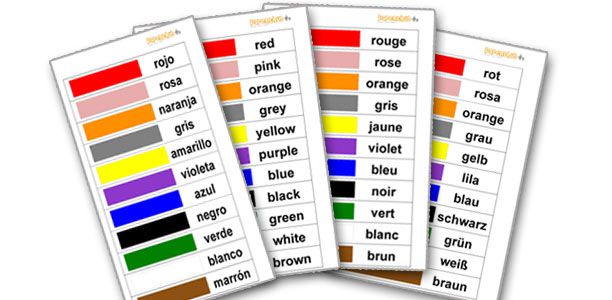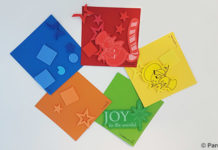Age
18 months to 4 years
Duration of activity
This activity is a great way of teaching colours and words. It takes less than ten minutes but you could repeat the activity in a second language.
Materials/equipment
- Paint sample colour cards (free from a hardware store) or a colour printer
- Velcro strips with a sticky back
- Laminator and laminating pouches.
- Velcro colour matching game template in one or more languages.
Cost
Making this activity should cost about $1-$1.50, but you may spend more if you don’t already have supplies at home. For example a big roll of Velcro strip costs about $18 from a stationary or craft shop (also check department stores like Kmart in their sewing section) – that would be enough to do this and many other crafts activities which need Velcro. It’s cheaper to buy things like Velcro and laminating pouches in bulk. However you could also buy a packet of Velcro dots for $4-5.
Preparation
- The template is available in multiple languages, so if you are teaching your child a second language, you may like to make two game boards.
For game board made with paint sample cards
- Collect paint sample cards from the local hardware or paint store. Take your child with you and talk to them about which shade of each colour they prefer and let them choose the shades they would like to use to make their colour matching board.
- Choose your language and the game board without the colours on it (you will stick on your own colours from the paint cards).
- Cut strips from the paint sample card- you will need two strips of each colour, cut to the same size as the space provided in the template.
- Paste one set of the strips into the corresponding space on the game board template (e.g. stick the blue strip next to the word blue).
- When all the colours have been stuck, laminate the game board.
- Laminate the other set of colour strips and cut them out.
- Cut Velcro strips (or use Velcro dots) and stick in the same place on the front of the colour game board template and on the back of the colour strips.
For game board printed in colour
- Choose the game board in the language you require and with the colours on it. Print it out.
- Laminate the game board.
- Laminate the colour sections template and cut them out.
- Cut Velcro strips (or use Velcro dots) and stick in the same place on the front of the colour game board template and on the back of the colour strips.
What to do
- Place the game board and colour strips in a place where your child can easily reach them to play.
- Instruct your child to stick each colour strip to the matching colour strip on the game board. They will attach by the Velcro.
Tips
- Talk to your child about the colours as you go. Ask them to say the name of the colour as they stick it to the board. You could also talk about day to day objects that are the same colour, which others colours it is similar or different to and whether or not they like the colour.
- Point to the words as your child matches the colours and point to the letters as you read each syllable. Even if your child is too young to read, you will be helping them develop understanding of text and the meaning of printed words.
Extension activities
- You could also get your child to peel the colour strips off the game board before they begin- it’s a great way to develop strength in their finger movements.
- For older children who are learning to read, use the colour matching game board template made for the paint sample cards but only cut out one set of colours. Don’t stick colours next to the word on the board template, just put the Velcro in the blank spot and get them to read the word (helping them to sound out the word if they have difficulty) and stick the correct colour next to it.
Educational outcomes
Mathematical skills
Recognising and matching colours is an important mathematical skill which children develop in their early years. Between 18-24 months children typically develop the ability to match colours (although they probably won’t have mastered the names of colours yet, and might tell you that the cards they are matching are red when they are in fact blue). By about three years of age they should be able to identify and discuss similarities and differences between colours. They will be developing their mathematical vocabulary and beginning to understand the words they need to use to compare things, for example light and dark colours.
Fine motor skills
Picking up the colour strips and sticking them to or peeling them off the game board using the Velcro strips is a great way for children to develop fine motor skills, that is, control of the fine muscles which move the fingers. Your child will use this important group of muscles to perform fiddly tasks like writing, turning pages and picking up small objects for the rest of their life.
Communication and social skills
The conversations you have with your child as you play this game will help them learn how to communicate effectively, for example to take turns at speaking and listening and answering when asked a question. They will also further their understanding of non-verbal communication, for example how a facial expression like a smile or a frown communicate a person’s feelings.
Language and literacy skills
The matching colours game also helps develop your child’s language and literacy skills. They will learn new words including mathematical words such as the colour names and comparative terms like light and dark. A young child’s vocabulary increases rapidly from about 300 words at age two, to 1000 words at age three and over 2000 by their sixth birthday. Speaking to your child in clear, simple language and giving them the opportunity to practice using new words (e.g. comparative words) and pronounce them is an important way to help your child develop their language skills.
Seeing the colour names printed on the game board template will develop children’s literacy skills or ability to read and write. Pointing to the words for each colour is a great way to help them learn to read. Small children may know the name of the colour when they see it and then pretend to read the word when you ask them what it says. Pretending to read is an important pre-reading step, so encourage it. Older children who recognise letters and are starting to read will benefit from sounding out the words.
Template downloads
 |
Colour sections template |
 |
For using paint sample cards – game boards without colour |
 |
For printing in colour – game boards with colours included |
You might also like…
 |
Colours |
References
- Virginia Early Childhood Development Alignment Program. Milestones of child development- A guide to young children’s learning and development from birth to kindergarten. 2009. (cited 26 July 2013). Available from: (URL Link)
- Queensland Health. Physical and cognitive milestones. 2007. (cited 31 July 2013). Available from: (URL Link)



 (7 votes, average: 4.43 out of 5)
(7 votes, average: 4.43 out of 5) 






